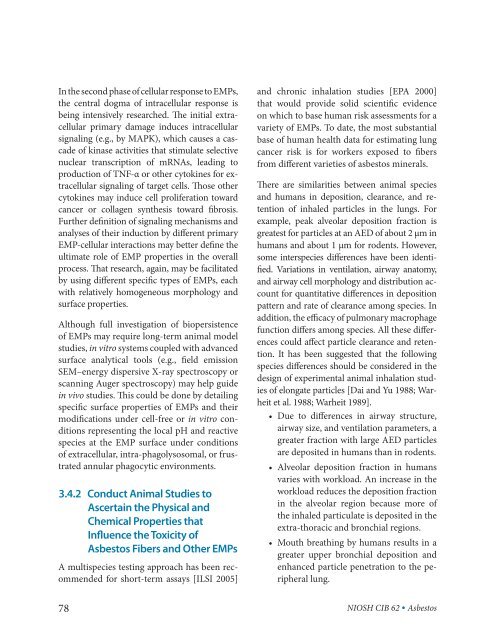Asbestos Fibers and Other Elongate Mineral Particles: State of the ...
Asbestos Fibers and Other Elongate Mineral Particles: State of the ...
Asbestos Fibers and Other Elongate Mineral Particles: State of the ...
- No tags were found...
You also want an ePaper? Increase the reach of your titles
YUMPU automatically turns print PDFs into web optimized ePapers that Google loves.
In <strong>the</strong> second phase <strong>of</strong> cellular response to EMPs,<br />
<strong>the</strong> central dogma <strong>of</strong> intracellular response is<br />
being intensively researched. The initial extracellular<br />
primary damage induces intracellular<br />
signaling (e.g., by MAPK), which causes a cascade<br />
<strong>of</strong> kinase activities that stimulate selective<br />
nuclear transcription <strong>of</strong> mRNAs, leading to<br />
production <strong>of</strong> TNF-α or o<strong>the</strong>r cytokines for extracellular<br />
signaling <strong>of</strong> target cells. Those o<strong>the</strong>r<br />
cytokines may induce cell proliferation toward<br />
cancer or collagen syn<strong>the</strong>sis toward fibrosis.<br />
Fur<strong>the</strong>r definition <strong>of</strong> signaling mechanisms <strong>and</strong><br />
analyses <strong>of</strong> <strong>the</strong>ir induction by different primary<br />
EMP-cellular interactions may better define <strong>the</strong><br />
ultimate role <strong>of</strong> EMP properties in <strong>the</strong> overall<br />
process. That research, again, may be facilitated<br />
by using different specific types <strong>of</strong> EMPs, each<br />
with relatively homogeneous morphology <strong>and</strong><br />
surface properties.<br />
Although full investigation <strong>of</strong> biopersistence<br />
<strong>of</strong> EMPs may require long-term animal model<br />
studies, in vitro systems coupled with advanced<br />
surface analytical tools (e.g., field emission<br />
SEM–energy dispersive X-ray spectroscopy or<br />
scanning Auger spectroscopy) may help guide<br />
in vivo studies. This could be done by detailing<br />
specific surface properties <strong>of</strong> EMPs <strong>and</strong> <strong>the</strong>ir<br />
modifications under cell-free or in vitro conditions<br />
representing <strong>the</strong> local pH <strong>and</strong> reactive<br />
species at <strong>the</strong> EMP surface under conditions<br />
<strong>of</strong> extracellular, intra-phagolysosomal, or frustrated<br />
annular phagocytic environments.<br />
3.4.2 Conduct Animal Studies to<br />
Ascertain <strong>the</strong> Physical <strong>and</strong><br />
Chemical Properties that<br />
Influence <strong>the</strong> Toxicity <strong>of</strong><br />
<strong>Asbestos</strong> <strong>Fibers</strong> <strong>and</strong> <strong>O<strong>the</strong>r</strong> EMPs<br />
A multispecies testing approach has been recommended<br />
for short-term assays [ILSI 2005]<br />
78<br />
<strong>and</strong> chronic inhalation studies [EPA 2000]<br />
that would provide solid scientific evidence<br />
on which to base human risk assessments for a<br />
variety <strong>of</strong> EMPs. To date, <strong>the</strong> most substantial<br />
base <strong>of</strong> human health data for estimating lung<br />
cancer risk is for workers exposed to fibers<br />
from different varieties <strong>of</strong> asbestos minerals.<br />
There are similarities between animal species<br />
<strong>and</strong> humans in deposition, clearance, <strong>and</strong> retention<br />
<strong>of</strong> inhaled particles in <strong>the</strong> lungs. For<br />
example, peak alveolar deposition fraction is<br />
greatest for particles at an AED <strong>of</strong> about 2 µm in<br />
humans <strong>and</strong> about 1 µm for rodents. However,<br />
some interspecies differences have been identified.<br />
Variations in ventilation, airway anatomy,<br />
<strong>and</strong> airway cell morphology <strong>and</strong> distribution account<br />
for quantitative differences in deposition<br />
pattern <strong>and</strong> rate <strong>of</strong> clearance among species. In<br />
addition, <strong>the</strong> efficacy <strong>of</strong> pulmonary macrophage<br />
function differs among species. All <strong>the</strong>se differences<br />
could affect particle clearance <strong>and</strong> retention.<br />
It has been suggested that <strong>the</strong> following<br />
species differences should be considered in <strong>the</strong><br />
design <strong>of</strong> experimental animal inhalation studies<br />
<strong>of</strong> elongate particles [Dai <strong>and</strong> Yu 1988; Warheit<br />
et al. 1988; Warheit 1989].<br />
• Due to differences in airway structure,<br />
airway size, <strong>and</strong> ventilation parameters, a<br />
greater fraction with large AED particles<br />
are deposited in humans than in rodents.<br />
• Alveolar deposition fraction in humans<br />
varies with workload. An increase in <strong>the</strong><br />
workload reduces <strong>the</strong> deposition fraction<br />
in <strong>the</strong> alveolar region because more <strong>of</strong><br />
<strong>the</strong> inhaled particulate is deposited in <strong>the</strong><br />
extra-thoracic <strong>and</strong> bronchial regions.<br />
• Mouth breathing by humans results in a<br />
greater upper bronchial deposition <strong>and</strong><br />
enhanced particle penetration to <strong>the</strong> peripheral<br />
lung.<br />
NIOSH CIB 62 • <strong>Asbestos</strong>

















